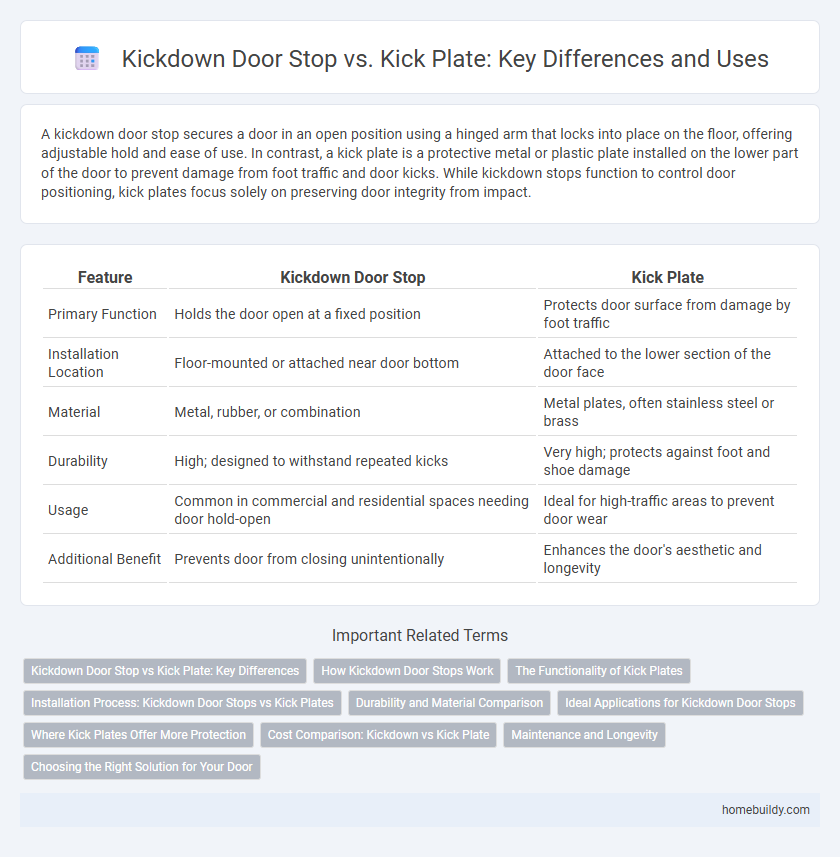A kickdown door stop secures a door in an open position using a hinged arm that locks into place on the floor, offering adjustable hold and ease of use. In contrast, a kick plate is a protective metal or plastic plate installed on the lower part of the door to prevent damage from foot traffic and door kicks. While kickdown stops function to control door positioning, kick plates focus solely on preserving door integrity from impact.
Table of Comparison
| Feature | Kickdown Door Stop | Kick Plate |
|---|---|---|
| Primary Function | Holds the door open at a fixed position | Protects door surface from damage by foot traffic |
| Installation Location | Floor-mounted or attached near door bottom | Attached to the lower section of the door face |
| Material | Metal, rubber, or combination | Metal plates, often stainless steel or brass |
| Durability | High; designed to withstand repeated kicks | Very high; protects against foot and shoe damage |
| Usage | Common in commercial and residential spaces needing door hold-open | Ideal for high-traffic areas to prevent door wear |
| Additional Benefit | Prevents door from closing unintentionally | Enhances the door's aesthetic and longevity |
Kickdown Door Stop vs Kick Plate: Key Differences
Kickdown door stops are designed to hold doors open by engaging a spring-loaded mechanism that secures the door at a fixed position on the floor, providing stability and easy release. Kick plates, often installed on the lower section of doors, serve to protect the door surface from damage caused by foot traffic or objects rather than to hold the door open. The key differences lie in function and placement: kickdown door stops control door movement and positioning, while kick plates focus solely on preventing wear and tear on the door material.
How Kickdown Door Stops Work
Kickdown door stops function by anchoring the door in an open position through a spring-loaded or friction-based mechanism that engages with the floor surface. When pressed down, the stop's arm locks the door securely, preventing it from swinging shut due to drafts or pressure changes. This design contrasts with kick plates, which protect the lower door surface from damage but do not control door movement.
The Functionality of Kick Plates
Kick plates serve as protective metal or plastic panels installed on the lower section of doors to prevent damage from frequent foot traffic, especially in commercial settings. Unlike kickdown door stops that physically hold a door open, kick plates enhance door durability by absorbing impacts and scuffs from kicks or carts, prolonging the life of the door surface. Their functionality is critical in maintaining door aesthetics and structural integrity where heavy usage or accidental contact is common.
Installation Process: Kickdown Door Stops vs Kick Plates
Kickdown door stops require mounting directly onto the door, involving drilling holes and securing with screws to ensure stability and effective floor contact. Kick plates, installed on the lower section of the door, typically demand surface preparation and precise alignment before fastening, often using screws or adhesive methods. The installation process of kickdown door stops is more straightforward and involves fewer steps compared to the more detailed surface preparation and positioning required for kick plates.
Durability and Material Comparison
Kickdown door stops typically feature robust metal constructions such as stainless steel or brass, offering high durability and resistance to wear in heavy-traffic areas. Kick plates, often mounted lower on doors, are usually crafted from thicker metal sheets like aluminum or steel to protect against scuffs and impacts, providing long-lasting surface reinforcement. When comparing materials, kickdown stops emphasize mechanical durability and functional longevity, while kick plates prioritize surface protection with resilient, impact-resistant metals.
Ideal Applications for Kickdown Door Stops
Kickdown door stops are ideal for securing doors in open positions, making them perfect for high-traffic areas such as classrooms, offices, and commercial buildings where hands-free operation is beneficial. They provide adjustable height settings to accommodate different floor surfaces, ensuring stability and preventing door damage. Unlike kick plates, which protect door edges from impact, kickdown stops prioritize functional door control and accessibility.
Where Kick Plates Offer More Protection
Kick plates offer more protection than kickdown door stops by covering a larger area at the base of the door, preventing damage from frequent kicking or scuffing. Made from durable materials like stainless steel or aluminum, kick plates resist dents, scratches, and wear from heavy traffic, making them ideal for high-use commercial or residential doors. Unlike kickdown stops that primarily hold doors open, kick plates reinforce the door surface, extending its lifespan and maintaining its appearance.
Cost Comparison: Kickdown vs Kick Plate
Kickdown door stops typically cost between $10 and $30, offering an affordable option for securing doors in an open position. Kick plates, which protect the lower door surface, range from $20 to $50 depending on material and size, making them a more expensive investment primarily aimed at preventing door damage. When comparing costs, kickdown stops provide a budget-friendly solution for door control, while kick plates serve dual purposes--protection and durability--justifying their higher price point.
Maintenance and Longevity
Kickdown door stops typically require regular cleaning and occasional lubrication to maintain smooth operation and prevent rust, ensuring long-term functionality. Kick plates offer enhanced durability by protecting the door surface from scuffs and damage, reducing the need for frequent repairs or replacements. Both components contribute to door longevity, but kick plates generally demand less maintenance compared to kickdown stops.
Choosing the Right Solution for Your Door
Kickdown door stops provide adjustable hold-open functionality, ideal for temporarily securing doors in open positions without damage. Kick plates protect door bottoms from scuffs and wear caused by foot traffic or equipment, enhancing durability but offering no hold-open feature. Selecting the right solution depends on whether you need to control door positioning or prioritize door protection and longevity.
Kickdown Door Stop vs Kick Plate Infographic

 homebuildy.com
homebuildy.com